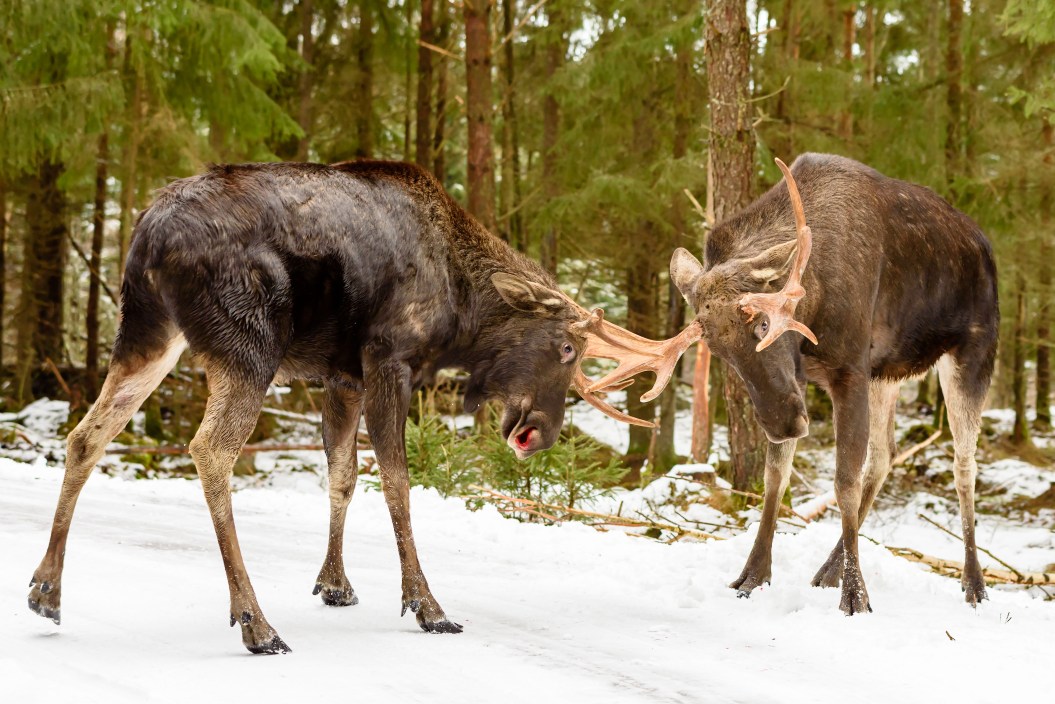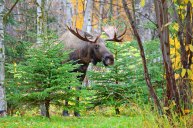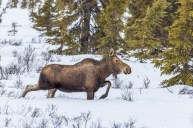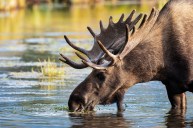I've worked as a mountain guide in Alaska for six years and spent over a decade recreating in some of the more remote corners of the Last Frontier. One of the most common questions I get is, "Aren't you afraid of bears?" While of course I give bears a healthy respect, I'm honestly more afraid of moose. After all, I've never had a negative encounter with a black or grizzly bear—but I have had several experiences with moose that scared me, from one charging me as I was cross-country skiing to another darting out in front of my truck at the last moment. As it turns out, I'm right to be concerned.
Why Moose Are a Bigger Threat Than Bears
The fact is, more people are injured by moose than bears in Alaska every year. While some of this is simply because moose outnumber both grizzlies and black bears combined, moose are also incredibly large and, in the winter, can undergo enormous food stress, making them territorial and more than a little hangry.
And it's not just in Alaska. As development continues to push into moose territory, other states such as Colorado are seeing an increase in moose-related injuries. In the past five years, 21 people have reported being injured by moose in Colorado, with six incidents occurring in 2022 alone.
But just how dangerous are moose, and what can you do to stay safe? I turned to my own experiences in Alaska and the Alaska Department of Fish and Game (ADFG) to find out. With Alaska's approximately 200,000 moose—more than any other state—the ADFG is the authority when it comes to managing moose-human interactions.
How Dangerous Are Moose?
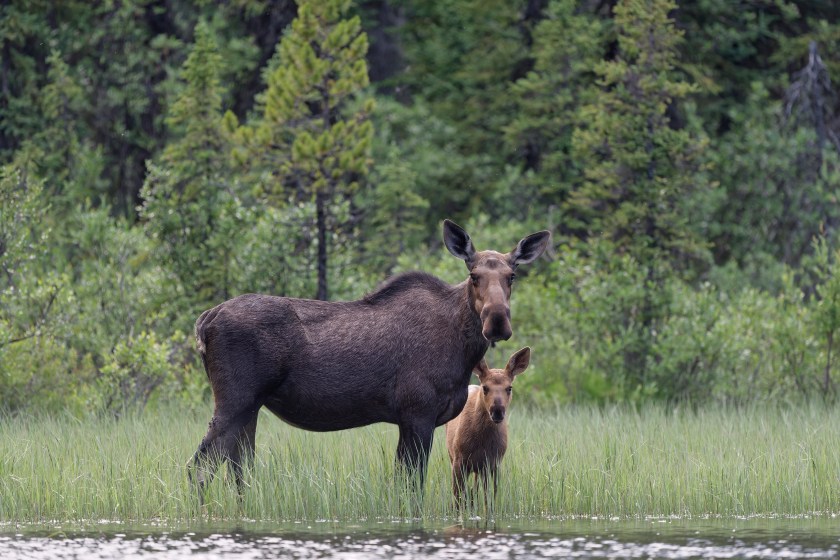
Getty Images, Wirestock
Moose aren't inherently aggressive, but like any wild animal, they can be unpredictable. A wildlife guide in Yellowstone told me that to help her clients understand why moose are dangerous animals, she likens them to teenagers: "You never know quite where their emotions lie and they can flip on a dime."
In addition, as one of the largest land animals in North America, moose can cause a lot of damage to people, cars, and infrastructure. Moose are massive; according to the ADFG, Alaskan moose can weigh up to 1,600 pounds and stand up to 7 feet tall at the shoulder. Bull moose also sport a set of antlers that can be up to 6 feet wide. The sheer size alone makes a negative encounter with one more likely to cause harm than, say, a whitetail deer.
And don't let their bulky looks make you doubt their athleticism: Moose can run up to 35 miles per hour and are fantastic swimmers. When threatened, they're also also known to kick with both their front hooves and their hind hooves, as well as rear and stomp. Those dinner-plate-sized hooves can cause some serious damage with just a glancing blow.
Are Moose Dangerous to Humans?
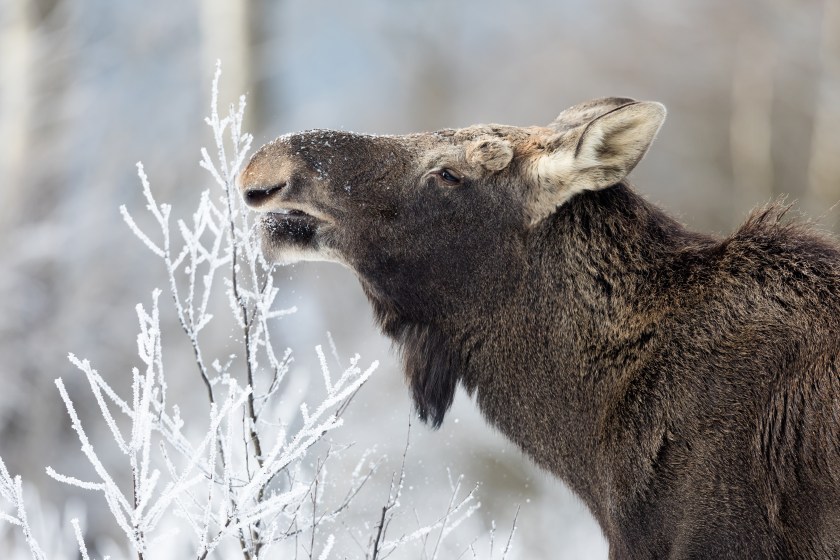
Getty Images, moose henderson
As prey animals, moose are not naturally aggressive or predatory. They subsist primarily off grasses, leaves, and aquatic vegetation, and they do not see humans as a possible food source. They also tend to flee when threatened. That's not necessarily a safe bet, however, and it certainly isn't a reason to get closer to any moose you see in the outdoors. Under certain circumstances (read more below), they can become aggressive toward humans. Because they're such large animals, even a mild attack can lead to serious injury for humans.
So, yes, meeting moose out in the backcountry can—and does—lead to injuries every year. But moose are most dangerous when they're on the road. Because moose have long legs, when a compact car hits them, it tends to hit low, dropping the massive body directly onto the vehicle and the windshield. This makes moose collisions far more dangerous than deer collisions. A study in Maine found that out of over 50,000 deer collisions, 10 resulted in fatalities—while out of over 7,000 vehicle collisions with moose, 26 resulted in fatalities. Likewise, studies have found that 20% of collisions with moose in Alaska lead to injury.
In What Situations Are Moose Most Dangerous?
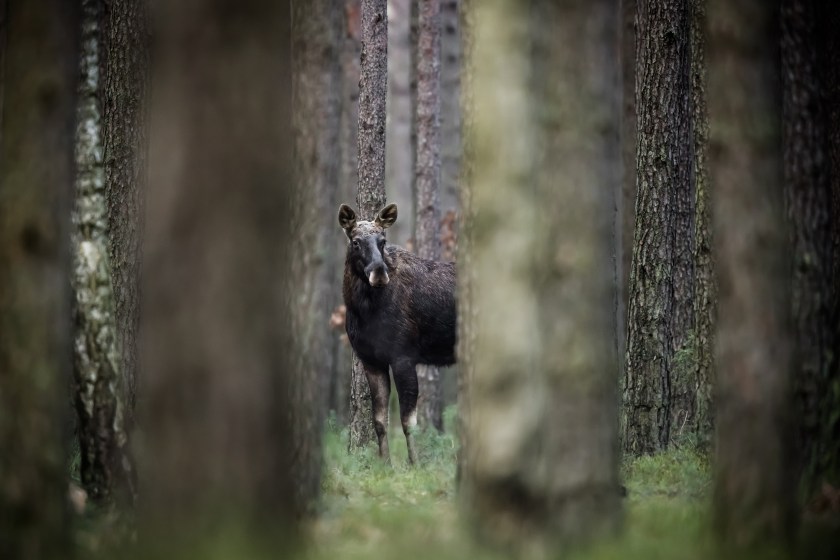
Getty Images, DamianKuzdak
Generally speaking, moose encounters tend to occur during certain times of year or even times of day and/or when moose are experiencing high levels of stress.
1. During Winter
Winter is a hard season for moose. Food is hard to come by, and deep snow can make walking to find additional food sources exhausting. According to the ADFG, moose become hungry and tired during winter and are territorial about their food sources; this increased stress can make them more aggressive.
Every one of my negative moose encounters has happened in Fairbanks, Alaska, where winter temperatures can drop down to minus 40 degrees Fahrenheit and snow can become deep and drifted in some places, making for difficult conditions for any person or animal trying to survive. There's also a high population of moose, and they tend to stray closer to roads and trails for ease of travel and to find food, increasing a person's chance of encountering them.
The winter of 2022 was particularly cold and snowy in interior Alaska, and moose run-ins skyrocketed; reports included moose charging people collecting firewood outside their house and moose attacking sled dogs.
2. When Moose Have Young Calves
Just like any animal, cow moose—aka female moose—are protective of their young. Moose calves are targets for predators such as bears and wolves, heightening a cow's anxiety. Most of my negative moose encounters have occurred because I unknowingly came between a cow moose and her calves. If you spot a calf, know that there is a mother nearby and slowly leave the area. Never approach a calf or a cow moose with calves.
3. When Moose Are in the Rut
Late September and October mark the moose mating season for most areas, and during this time bull moose can be very territorial and aggressive toward humans. You can expect them to be even more unpredictable than usual, and bull moose are full of hormones at this time and are primed to fight. Bull moose often spar and fight with each other during the rut to establish dominance.
Moose hunting season is typically right before or during rutting season, so if you're looking to bag a moose, be aware that they are more aggressive during this time.
4. When Moose Wander Onto Roads
As noted above, moose are most dangerous when you are driving a vehicle. It's estimated that 800 moose are hit in Alaska each year; the moose often don't survive, and people can be killed or seriously hurt. Roadside vegetation attracts moose near the road year-round; but winter months are the most dangerous, as moose often save energy by walking on traveled roads instead of through snow.
Moose are also most active right around sunrise and sunset, so be particularly aware of the road and the sides of the road during these times.
Are Moose Dangerous to Dogs or Cats?
Your typical house cat isn't going to provoke a moose to attack, generally speaking. Dogs, on the other hand, are an entirely different matter. Wolves are one of the few predators capable of taking down a moose or a calf, and a dog looks and acts enough like a wolf for a moose not to discriminate—they may see your dog as a predator and act accordingly. This isn't helped by the fact that most dogs, when confronted with moose, are liable to bark and otherwise act threateningly.
Several of Colorado's recent moose attacks happened to people who were walking their dogs. And, in 2022, a bull moose spent an hour attacking an Alaskan sled dog team, refusing to stop even after the musher emptied her gun into him.
If you must bring a pet along into forested areas, keep your dog under control and on a short leash in moose territory, particularly during high-stress seasons such as the rut and winter, advises Colorado Parks & Wildlife. Off-leash dogs are a danger in moose territory not only to themselves but the moose and people around them. The best advice, though, is to leave Fido at home and walk him in more-populated areas where moose are less likely to roam.
How to Stay Safe From Moose
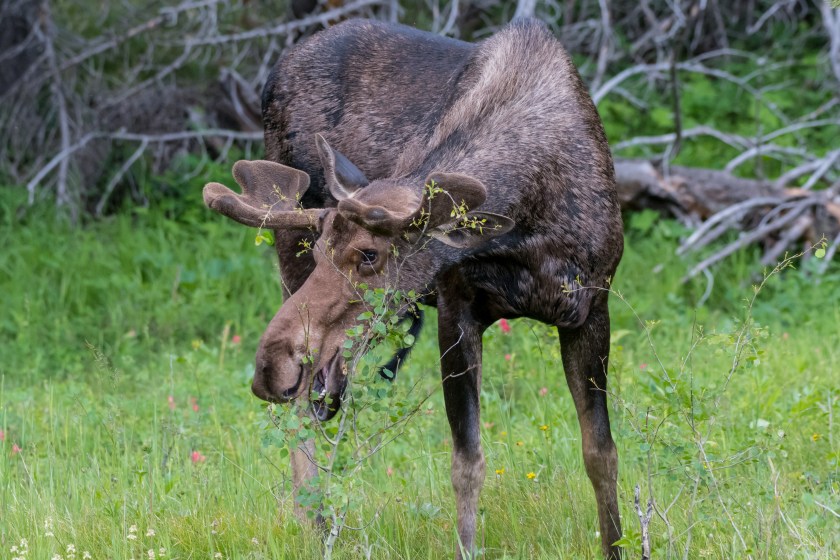
Getty Images, kellyvandellen
The best way to stay safe from moose is to remain alert to your surroundings and look for moose signs such as tracks. If you encounter a moose, back away slowly. Each moose has a different tolerance level when threatened, and it's best to give any moose a wide berth, be it a bull moose or a cow moose with calves.
Do not ever harass a moose by approaching them, throwing things at them, or letting your dog bark or approach them. In high-stress seasons, very little is needed to provoke a moose.
If a moose is blocking your way, look for another way around the animal, particularly a path where you can put a large tree, vehicle, or house between you and the moose. Otherwise, be patient. Moose will move eventually. Always leave moose obvious escape routes to help prevent them from feeling cornered by you.
If you're unable to avoid a moose entirely, look for these moose-behavior warning signs listed by the ADFG that will clue you into an increasingly aggressive moose: laid-back ears, raised hackles on its hump, and licking of lips. If a moose slowly starts walking toward you, it's not trying to be your friend. It's either habituated to humans and looking for food or warning you to keep away. Leave the area immediately or duck behind a tree, building, or car if complete escape isn't possible.
What Happens When a Moose Attacks?
If a moose feels suitably threatened, it will charge you. Many times, these are bluff charges meant to warn you to stay away. However, it's best to treat every charge as if the moose is fully triggered. Simply being hit by this freight train of an animal will cause injury, let alone the subsequent trampling and stomping after the moose has gotten you on the ground.
Unlike bears, moose will generally not chase you if you run. They don't have a predator's instinct, so running from them is generally enough to show that you mean no harm. Therefore, run away and get behind something solid such as the nearest tree or vehicle as quickly as you can—you won't outrun a charging moose at full speed, but you may be able to dodge him.
If a moose catches up to you and knocks you down, it will start stomping and kicking. Curl up in a ball, protect your head with your hands, and stay still. Wait until the moose moves a safe distance away before getting up.
READ MORE: Moose vs. Elk: How to Tell The Difference, and So Much More
